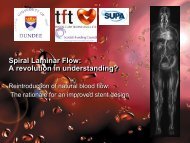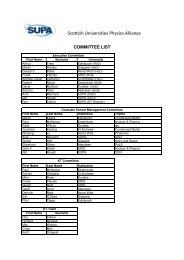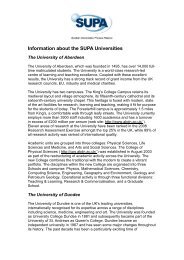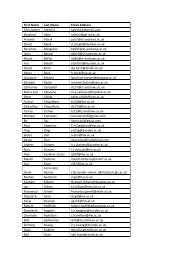Catalogue of Courses & Student Handbook - SUPA
Catalogue of Courses & Student Handbook - SUPA
Catalogue of Courses & Student Handbook - SUPA
You also want an ePaper? Increase the reach of your titles
YUMPU automatically turns print PDFs into web optimized ePapers that Google loves.
Particle Physics<br />
The <strong>SUPA</strong> Graduate School runs an extensive programme <strong>of</strong> Particle<br />
Physics courses to provide new graduate students with the necessary<br />
skills required to carry out research. The Particle Physics courses<br />
are divided into categories corresponding to whether the student is<br />
undertaking theoretical or experimental research, core lectures are<br />
compulsory for first year students in both areas.<br />
Theory <strong>Student</strong>s are strongly recommended to attend all the<br />
‘Common Core’ and ‘Theory Core’ courses. Experimentalists are strongly<br />
recommended to attend all the ‘Common Core’ and ‘Experiment Core’<br />
courses. Theory students are also welcome to attend courses in the<br />
experiment core and vice versa. <strong>Student</strong>s should discuss with their<br />
supervisor which optional courses they should attend.<br />
Semester 1<br />
Accelerators (<strong>SUPA</strong>ACC)<br />
Lecturer: Dino Jaroszynski & Mark Wiggins<br />
Institution: Strathclyde<br />
Hours Equivalent Credit: 9<br />
Assessment: Continuous Assessment<br />
Experimental Core This course is crossed linked with the Nuclear<br />
and Plasma Physics Theme<br />
Course Description<br />
The course will cover the following topics:<br />
(i) overview and history <strong>of</strong> the accelerators and outlook for future<br />
advances including the development <strong>of</strong> laser-driven accelerators,<br />
(ii) accelerator applications including medical imaging, isotope<br />
production and oncology, (iii) RF accelerating cavities including<br />
waveguide propagation, superconducting cavities and power delivery,<br />
(iv) beam line diagnostics for characterising beam parameters such as<br />
charge, transverse pr<strong>of</strong>ile, energy spread and emittance, (v) transverse<br />
and longitudinal beam dynamics outlining beam parameters and<br />
transport and the effect <strong>of</strong> beam quality on transport and focusing, (vi)<br />
non-linear beam dynamics including resonances, betatron motion and<br />
beam instabilities, (vii) electromagnetic radiation emitted by relativistic<br />
charged particles due to their acceleration: synchrotron and betatron,<br />
(viii) radiation damping and application <strong>of</strong> such radiation.<br />
Detectors (<strong>SUPA</strong>DET)<br />
Lecturer: Stephan Eisenhardt, Richard Bates & Andrew Blue<br />
Institution: Glasgow & Edinburgh<br />
Hours Equivalent Credit: 16 (11 lectures, 1x2hr lab & 1x3hr Lab)<br />
Assessment: Continuous assessment using problem sheets<br />
Experimental Core<br />
Course Description<br />
The course will give a comprehensive view on the many techniques<br />
and technologies utilised in the building <strong>of</strong> particle physics detectors.<br />
The series <strong>of</strong> 11 hours <strong>of</strong> lectures is complemented by 5 hours <strong>of</strong><br />
practical sessions. In the first series <strong>of</strong> lectures, taught by Stephan<br />
Eisenhardt, the students learn about classical detector technologies<br />
and concepts that form the basis <strong>of</strong> the modern developments.<br />
The principles <strong>of</strong> the interaction <strong>of</strong> radiation with matter are discussed.<br />
From principles to state-<strong>of</strong>-the-art applications, the following<br />
technologies are reviewed: gaseous tracking detectors, photon<br />
detectors and calorimeters. The methods utilised for particle<br />
identification as well as concepts to trigger on rare events are presented.<br />
Finally, the students are introduced to how all these building blocks are<br />
combined into modern layouts <strong>of</strong> particle physics detectors. The second<br />
series <strong>of</strong> lectures, taught by Richard Bates, focuses entirely on the<br />
physics and applications <strong>of</strong> Solid State Detectors. Their ever-increasing<br />
use in particle physics detectors is motivated; their application in the<br />
past, in the present and in the near future is reviewed. The fundamental<br />
configurations and properties <strong>of</strong> semiconductors are introduced and<br />
the process <strong>of</strong> signal formation in semiconductor detectors is discussed.<br />
The properties <strong>of</strong> the microstrip detector are examined in detail as an<br />
example <strong>of</strong> a detector type commonly used today. Radiation damage is<br />
the most limiting effect to semiconductor detectors; its effects and cures<br />
are presented. In the concluding lecture, Andrew Blue teaches about the<br />
fabrication <strong>of</strong> semiconductors. The main production techniques and their<br />
limitations are presented including lithography, additive and subtractive<br />
processes, etching, SiO2 layers and doping. Finally, the semiconductor<br />
processing facilities at the Glasgow Electrical Engineering Department<br />
are outlined. A two-hour session taking place in a laboratory at<br />
Edinburgh will demonstrate a state-<strong>of</strong>-the-art application <strong>of</strong> novel photon<br />
detectors on the test bench. One focus will be on the integration <strong>of</strong><br />
control, data acquisition and logging into an integrated test system using<br />
Labview. In addition the basics <strong>of</strong> signal transmission, interfacing kit <strong>of</strong><br />
hardware and safety when working with high voltages and radioactive<br />
sources will be covered. The second laboratory session held in Glasgow<br />
will last 3 hours. The session will initially explore the electrical behaviour<br />
<strong>of</strong> silicon detectors. After this the response <strong>of</strong> the detector to an IR<br />
light pulse as a function <strong>of</strong> detector bias voltage will be examined.<br />
Two different detector designs will be used to allow the student to<br />
measure the different characteristics <strong>of</strong> these devices. The laboratory<br />
will give the student the opportunity to measure the type <strong>of</strong> silicon<br />
detectors that are discussed in detail in the second part <strong>of</strong> the lecture<br />
course. The course is self-contained and requires no prior knowledge<br />
<strong>of</strong> the field. <strong>Student</strong>s will be assessed using problem sheets.<br />
Particle Physics<br />
20







